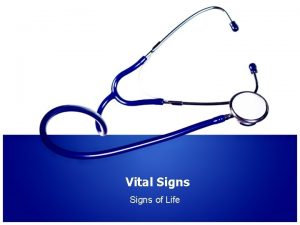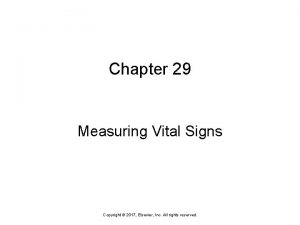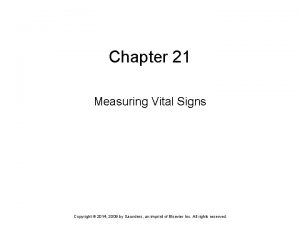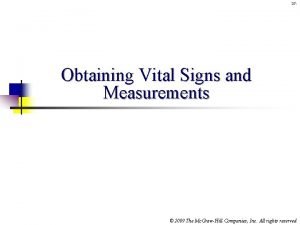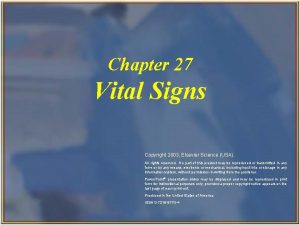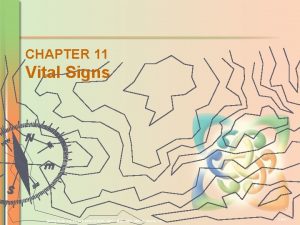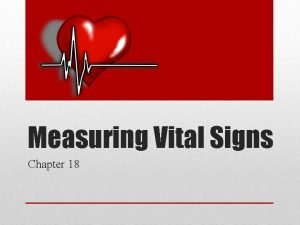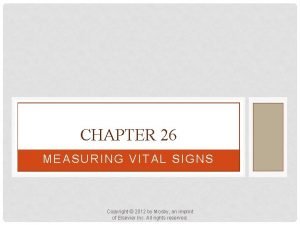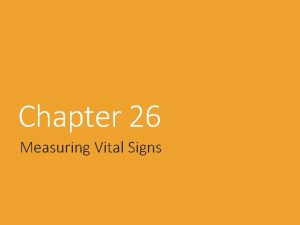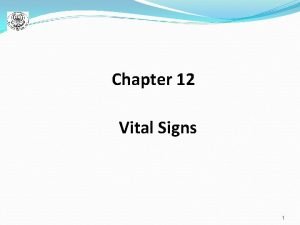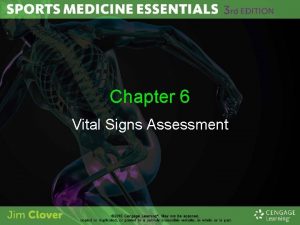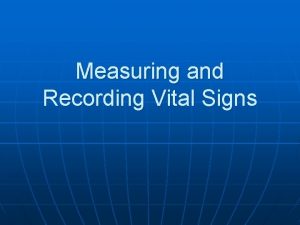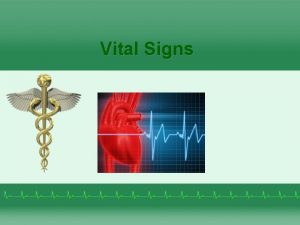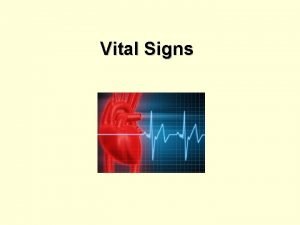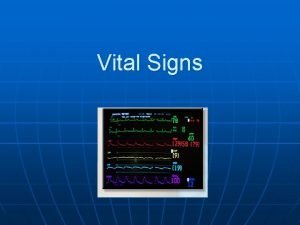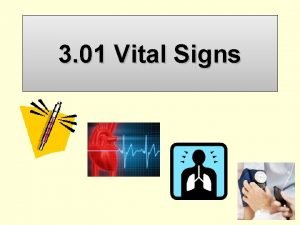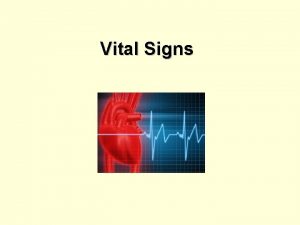Chapter 16 Vital Signs Copyright 2014 Cengage Learning




























- Slides: 28

Chapter 16 Vital Signs Copyright © 2014 Cengage Learning. All Rights Reserved. May not be scanned, copied or duplicated, or posted to a publicly accessible website, in whole or in part.

16: 1 Measuring and Recording Vital Signs • Vital signs provide information about a patient’s basic body conditions • Temperature – Measure of balance between heat lost and produced by body – Usually measured on Fahrenheit scale Copyright © 2014 Cengage Learning. All Rights Reserved. May not be scanned, copied or duplicated, or posted to a publicly accessible website, in whole or in part.

16: 1 Measuring and Recording Vital Signs (continued) • Pulse – Pressure of blood felt against wall of an artery – Rate: number of beats per minute – Rhythm: regularity – Volume: strength, force, or quality Copyright © 2014 Cengage Learning. All Rights Reserved. May not be scanned, copied or duplicated, or posted to a publicly accessible website, in whole or in part.

16: 1 Measuring and Recording Vital Signs (continued) • Respirations – Patient’s breathing rate • Blood pressure – Force exerted by blood against arterial walls • Apical pulse – Taken with stethoscope at apex of heart Copyright © 2014 Cengage Learning. All Rights Reserved. May not be scanned, copied or duplicated, or posted to a publicly accessible website, in whole or in part.

16: 2 Measuring and Recording Temperature • Temperature measures balance between heat lost and heat produced in the body – Heat lost through perspiration, respiration, excretion – Heat produced by food metabolism, muscle and gland activity • Homeostasis – Constant state of fluid balance in the body Copyright © 2014 Cengage Learning. All Rights Reserved. May not be scanned, copied or duplicated, or posted to a publicly accessible website, in whole or in part.

Variations in Body Temperature • Normal range: 97°to 100° Fahrenheit • Causes of variations – Individual differences – Time of day – Body sites (refer to Table 16 -1 in Text) Copyright © 2014 Cengage Learning. All Rights Reserved. May not be scanned, copied or duplicated, or posted to a publicly accessible website, in whole or in part.

Variations in Body Temperature (continued) • • • Oral temperature Rectal temperature Axillary temperature Aural temperature Temporal temperature Copyright © 2014 Cengage Learning. All Rights Reserved. May not be scanned, copied or duplicated, or posted to a publicly accessible website, in whole or in part.

Variations in Body Temperature (continued) • Hypothermia – Body temperature below 95°F • Pyrexia (fever) – Body temperature above 101°F • Hyperthermia – Rectal body temperature exceeding 104°F Copyright © 2014 Cengage Learning. All Rights Reserved. May not be scanned, copied or duplicated, or posted to a publicly accessible website, in whole or in part.

Types of Thermometers • Clinical thermometers – Slender glass tube containing mercury – Used by few health care agencies – Danger of mercury contamination • Electronic thermometers – Used in most health care facilities Copyright © 2014 Cengage Learning. All Rights Reserved. May not be scanned, copied or duplicated, or posted to a publicly accessible website, in whole or in part.

Types of Thermometers (continued) • Tympanic thermometers • Temporal scanning thermometers – Accurate and noninvasive for internal body temperature • Plastic or disposable thermometers Copyright © 2014 Cengage Learning. All Rights Reserved. May not be scanned, copied or duplicated, or posted to a publicly accessible website, in whole or in part.

Reading and Recording Temperature • Record temperature to the nearest two-tenths of a degree • Refer to Figure 16 -9 in Text • Record to avoid error in reading Copyright © 2014 Cengage Learning. All Rights Reserved. May not be scanned, copied or duplicated, or posted to a publicly accessible website, in whole or in part.

Cleaning Thermometers • Clean thermometers thoroughly after each use • Use cool water on glass thermometers to prevent breakage • Disposable plastic sheath may be used • Follow agency policies Copyright © 2014 Cengage Learning. All Rights Reserved. May not be scanned, copied or duplicated, or posted to a publicly accessible website, in whole or in part.

16: 3 Measuring and Recording Pulse • Pulse – Pressure of blood pushing against the wall of an artery as the heart beats and rests • Major arterial or pulse sites – Refer to Figure 16 -18 in Text Copyright © 2014 Cengage Learning. All Rights Reserved. May not be scanned, copied or duplicated, or posted to a publicly accessible website, in whole or in part.

16: 3 Measuring and Recording Pulse (continued) • Pulse rate – Number of beats per minute – Bradycardia: pulse rate under 60 beats/minute – Tachycardia: pulse rate over 100 beats/minute • Pulse rhythm – Regularity of pulse – Arrhythmia Copyright © 2014 Cengage Learning. All Rights Reserved. May not be scanned, copied or duplicated, or posted to a publicly accessible website, in whole or in part.

16: 3 Measuring and Recording Pulse (continued) • Pulse volume – Strength, force, quality, or intensity of pulse – Strong, weak, thready, bounding • Factors that change pulse rate • Measuring and recording radial pulse – Refer to Procedure 16: 3 in Text Copyright © 2014 Cengage Learning. All Rights Reserved. May not be scanned, copied or duplicated, or posted to a publicly accessible website, in whole or in part.

16: 4 Measuring and Recording Respirations • Respiration – Process of taking in oxygen and expelling carbon dioxide from lungs and respiratory tract • One respiration – One inspiration (breathing in) and one expiration (breathing out) Copyright © 2014 Cengage Learning. All Rights Reserved. May not be scanned, copied or duplicated, or posted to a publicly accessible website, in whole or in part.

16: 4 Measuring and Recording Respirations (continued) • Rate of respirations – Number of breaths per minute • Character of respirations – Depth and quality of respirations • Rhythm of respirations – Regularity of respirations/space between breaths Copyright © 2014 Cengage Learning. All Rights Reserved. May not be scanned, copied or duplicated, or posted to a publicly accessible website, in whole or in part.

16: 4 Measuring and Recording Respirations (continued) • Abnormal respirations – Dyspnea – Apnea – Tachypnea – Bradypnea – Orthopnea – Cheyne-Stokes – Rales – Wheezing – Cyanosis Copyright © 2014 Cengage Learning. All Rights Reserved. May not be scanned, copied or duplicated, or posted to a publicly accessible website, in whole or in part.

16: 5 Graphing TPR • Graphic sheets are used for recording temperature, pulse, and respirations (TPR) • Presents a visual diagram of variations in patient’s vital signs • May use color coding • Refer to Procedure 16: 5 in Text Copyright © 2014 Cengage Learning. All Rights Reserved. May not be scanned, copied or duplicated, or posted to a publicly accessible website, in whole or in part.

16: 5 Graphing TPR (continued) • Factors affecting vital signs are often noted • Computerized graphs may be printed or kept in the electronic health record (EHR) • Graphic charts are legal medical records – Neat, legible, accurate – Correct all errors Copyright © 2014 Cengage Learning. All Rights Reserved. May not be scanned, copied or duplicated, or posted to a publicly accessible website, in whole or in part.

16: 6 Measuring and Recording Apical Pulse • Pulse count taken with stethoscope at apex of the heart • Usually ordered by physician • Reasons for taking an apical pulse • Protect patient’s privacy and avoid exposure Copyright © 2014 Cengage Learning. All Rights Reserved. May not be scanned, copied or duplicated, or posted to a publicly accessible website, in whole or in part.

16: 6 Measuring and Recording Apical Pulse (continued) • Two heart sounds • Pulse deficit – Difference between apical and radial pulse • Refer to Procedure 16: 6 in Text Copyright © 2014 Cengage Learning. All Rights Reserved. May not be scanned, copied or duplicated, or posted to a publicly accessible website, in whole or in part.

16: 7 Measuring and Recording Blood Pressure • Measurement of pressure blood exerts on walls of arteries during various stages of heart activity • Read in millimeters (mm) of mercury (Hg) on a sphygmomanometer • Measurements read at two points Copyright © 2014 Cengage Learning. All Rights Reserved. May not be scanned, copied or duplicated, or posted to a publicly accessible website, in whole or in part.

16: 7 Measuring and Recording Blood Pressure (continued) • Systolic pressure – Pressure in walls of arteries when left ventricle contracts • Diastolic pressure – Constant pressure in walls of arteries when left ventricle is at rest Copyright © 2014 Cengage Learning. All Rights Reserved. May not be scanned, copied or duplicated, or posted to a publicly accessible website, in whole or in part.

16: 7 Measuring and Recording Blood Pressure (continued) • Pulse pressure – Difference between systolic and diastolic pressure • Hypertension (high blood pressure) – Greater than 140 mm Hg systolic, 90 mm Hg diastolic Copyright © 2014 Cengage Learning. All Rights Reserved. May not be scanned, copied or duplicated, or posted to a publicly accessible website, in whole or in part.

16: 7 Measuring and Recording Blood Pressure (continued) • Hypotension (low blood pressure) – Less than 90 mm Hg systolic, 60 mm Hg diastolic • Refer to Table 16 -2 in Text for adult blood pressure classifications Copyright © 2014 Cengage Learning. All Rights Reserved. May not be scanned, copied or duplicated, or posted to a publicly accessible website, in whole or in part.

16: 7 Measuring and Recording Blood Pressure (continued) • Individual factors can influence blood pressure readings, increase or decrease blood pressure • Types of sphygmomanometers – Mercury – Aneroid – Electronic Copyright © 2014 Cengage Learning. All Rights Reserved. May not be scanned, copied or duplicated, or posted to a publicly accessible website, in whole or in part.

16: 7 Measuring and Recording Blood Pressure (continued) • AHA factors to observe for accurate readings – 5 minutes of quiet rest – Take two separate readings and average • Correct cuff size is essential for accuracy • Refer to Procedure 16: 7 in Text Copyright © 2014 Cengage Learning. All Rights Reserved. May not be scanned, copied or duplicated, or posted to a publicly accessible website, in whole or in part.
 2014 cengage learning accounting answers
2014 cengage learning accounting answers 2014 cengage learning
2014 cengage learning Cengage chapter 7
Cengage chapter 7 Sign sign everywhere a sign
Sign sign everywhere a sign Normal vitals
Normal vitals Chapter 14 basic nursing skills
Chapter 14 basic nursing skills Chapter 13 medical math assignment sheet cengage learning
Chapter 13 medical math assignment sheet cengage learning Chapter 7 cengage
Chapter 7 cengage Chapter 14:1 measuring and recording vital signs
Chapter 14:1 measuring and recording vital signs Sign chapter 37
Sign chapter 37 Chapter 29 measuring vital signs
Chapter 29 measuring vital signs Measuring vital signs chapter 21
Measuring vital signs chapter 21 Chapter 16:3 measuring and recording pulse
Chapter 16:3 measuring and recording pulse Chapter 36 body measurements and vital signs
Chapter 36 body measurements and vital signs Fundamentals of nursing chapter 17 vital signs
Fundamentals of nursing chapter 17 vital signs Chapter 27 vital signs
Chapter 27 vital signs Test chapter 16 vital signs
Test chapter 16 vital signs Apical pulse
Apical pulse Chapter 11 vital signs
Chapter 11 vital signs Chapter 26 measuring vital signs
Chapter 26 measuring vital signs Chapter 26 measuring vital signs
Chapter 26 measuring vital signs Chapter 15:6 measuring and recording apical pulse
Chapter 15:6 measuring and recording apical pulse Volúmenes pulmonares
Volúmenes pulmonares Copyright 2014 pearson education inc
Copyright 2014 pearson education inc Chapter 6:2 interpreting word parts
Chapter 6:2 interpreting word parts Medical terminology chapter 5 learning exercises answers
Medical terminology chapter 5 learning exercises answers Cengage learning heart diagram
Cengage learning heart diagram South-western cengage learning
South-western cengage learning 2009 delmar cengage learning
2009 delmar cengage learning




